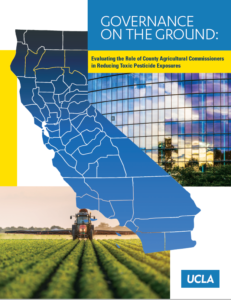Governance on the Ground—Evaluating Pesticide Regulation in California
In a new study, UCLA and USC researchers find that California state and county officials are falling short in evaluating use of agricultural pesticides.
Editor’s note: a new report from researchers at UCLA and USC provides a systematic review of California’s county-level regulation of pesticides. Read the report, a 4-page summary, and a press release.

specialty crops. Photo credit: Fotokostic, Shutterstock
It is well known that the law on the ground often looks quite different than the law on the books.
California’s pesticide regulatory program is a remarkable case in point.
First, a bit of background about California’s program, which creates a two-tiered process for reviewing toxic pesticides before they are used in the fields. At the state level, new pesticides must be approved by the state Department of Pesticide Regulation (DPR) through the registration process. Based upon scientific reviews and (if needed) risk assessment, DPR must establish measures to protect the environment and the health of agricultural workers and of other individuals who live, work or engage in activities nearby. DPR also classifies pesticides of significant concern as restricted materials. At the county level, each of the fifty-six County Agricultural Commissioners (CACs) runs a restricted materials permitting programs. In evaluating restricted materials permit application, the CAC must use their knowledge of local conditions to determine if use the pesticide may lead to a substantial adverse environmental impact.
For decades state law has mandated that as part of their respective responsibilities, both DPR and the CACs must consider two critical issues. First, are there safer alternatives to the use of the pesticide in question? Second, will use of the pesticide result in harmful cumulative exposures (i.e., exposures associated with simultaneous or sequential application of two or more materials at the same field or at adjacent fields)? In prior reports that can be found here and here, we found that DPR ignores these questions during registration. Our most recent report shifts focus to the local level, providing the first systematic review of the CACs’ policy and practices regarding alternatives evaluation and cumulative exposure assessment.

The study used a mixed-method approach to evaluate the CACs’ evaluation of potentially safer alternatives and of cumulative exposure. We first performed a broad, statewide assessment of existing permit evaluation policies of all CACs followed by focused case studies. The broad assessment involved the review of documents and information gathered through extensive online searches of relevant government websites. The gathered information, which included county work plans and pesticide use reports, was used to characterize permitting practices by each of the fifty-six CACs in California. Using permitting documentation received from Public Records Act requests, the case studies delved more deeply into the practices of a representative subset of twenty-four CACs.
Regarding alternatives evaluation, although our statewide review showed that almost 60% of the CACs profess varying levels of commitment to alternatives evaluation, the permit files and records provided by the selected CACs contradict the expressed level of commitment. Our case study examined permitting of chlorpyrifos, an organophosphate with substantial demonstrated health risks. None of the responding CACs reported having office-specific written guidance relevant to alternatives evaluation. CACs typically delegate the responsibility to identify and evaluate potentially feasible alternatives to the applicant (or, more specifically, to the applicant’s private pest control advisor). In addition, there was no evidence that the CACs engage in oversight of the private parties’ alternatives evaluation activities.
Cumulative exposure assessment fared no better. Here the case study centered on permitting of chloropicrin, 1,3-dichloropropene (Telone), and metam sodium. The statewide review showed that CACs do not consider cumulative exposure during the county restricted material permitting process. Additionally, in the case study, the permitting documents received in response to our records requests provided no evidence of cumulative exposure evaluation by CAC personnel. There are no records memorializing discussions with applicants or their representatives regarding potential concerns about cumulative exposures. From our analysis of the documents provided in response to the PRA requests, when multiple fumigants are applied to the same or adjacent fields no special mitigation measures are imposed.
The report sets out a set of recommendations aimed at aligning on the law on the ground with the law on the books, including:
- Develop DPR guidance that sets out rigorous but realistic methods for CACs to follow in identifying and evaluating potential alternatives for restricted pesticides.
- Adopt practices for DPR and CACs to identify cumulative exposure scenarios at the registration and permitting stages.
- Establish guidance and methods for testing mixtures when pesticides are being registered by the DPR, and modelling or monitoring cumulative exposures occurring in the field.
- Create a task force to establish methods for assessing risks associated with cumulative exposures and measures for preventing or mitigating those risks.
Reader Comments
One Reply to “Governance on the Ground—Evaluating Pesticide Regulation in California”
Comments are closed.







The situation spelled out here is neither new or startling. As a header, it falls under the topic of regulatory clientele capture. Both Hap Dunning and I had written essentially on this exact subject nearly five decades ago. See circa 1972: H. Dunning: Law Review: Pests, Poisons, and the Living Law and see McGowan, The Pesticide Report: Pesticide Regulation in California Registration and Use Control— Legislative Analyst and its follow-on review. Six months following the LAO report, the CDF&A brought out its own analysis that reflected the findings of the LAO report.
Bill Gower and I, both at the UCD Dept of Envir. Tox, went on develop out of the Pesticide Use Report data, the computer-driven county mapping program. This was a map unique to each county and showed pesticide usage from data by location of application, acreage, crop, pesticide application type, all extracted from the pesticide use reports. The fact that the DPR exists is basically from these early efforts. This mapping basically allowed for a cumulative record and evaluation of what was going on the ground, where, when, and on what for enhanced management.
Prior to these efforts and a change in the law, three staff at the CDF&A were evaluating something like 40,000 pesticides annually for license to be used in this state.
Dr Edo McGowan